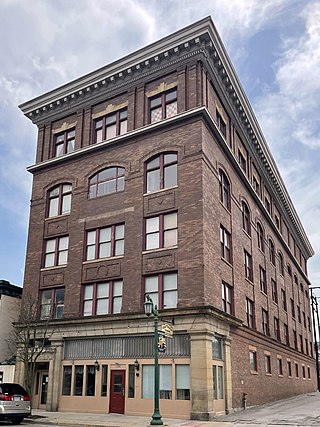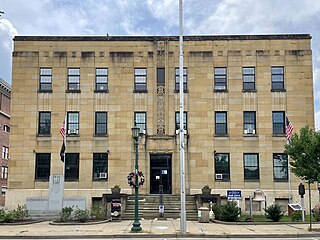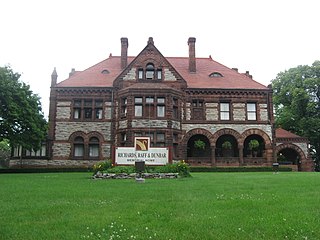
East Liverpool is a city in southeastern Columbiana County, Ohio, United States. The population was 9,958 at the 2020 census. It lies along the Ohio River at the intersection of Ohio, Pennsylvania and West Virginia about 30 miles (48 km) from both Pittsburgh and Youngstown. The city is most notable for its pottery industry, which was at one time the largest in the US.

Victorian architecture is a series of architectural revival styles in the mid-to-late 19th century. Victorian refers to the reign of Queen Victoria (1837–1901), called the Victorian era, during which period the styles known as Victorian were used in construction. However, many elements of what is typically termed "Victorian" architecture did not become popular until later in Victoria's reign, roughly from 1850 and later. The styles often included interpretations and eclectic revivals of historic styles (see Historicism). The name represents the British and French custom of naming architectural styles for a reigning monarch. Within this naming and classification scheme, it followed Georgian architecture and later Regency architecture and was succeeded by Edwardian architecture.

Hunting Lodge Farm is a historic house located near Oxford in Oxford Township, Butler County, Ohio, United States. Constructed as a hunting lodge, it has been used by multiple prominent local residents, and its distinctive architecture has made it worthy of designation as a historic site.

The shingle style is an American architectural style made popular by the rise of the New England school of architecture, which eschewed the highly ornamented patterns of the Eastlake style in Queen Anne architecture. In the shingle style, English influence was combined with the renewed interest in Colonial American architecture which followed the 1876 celebration of the Centennial. The plain, shingled surfaces of colonial buildings were adopted, and their massing emulated.

The Central Avenue Historic District is a small segment of the larger Grafton Hill neighborhood of Dayton, Ohio, United States. Composed of just two blocks near the border between Grafton Hill and Dayton View, the historic district comprises a cohesive collection of houses dating primarily from the turn of the 20th century, and it has been named a historic site.

St. Louis Catholic Church is a historic Roman Catholic church in North Star, Ohio, United States. Constructed in the early twentieth century, it is one of the newest churches in a heavily Catholic region of far western Ohio, but it has been recognized as a historic site because of its unique architecture.

The Elks Club in East Liverpool, Ohio was built in 1916. It was listed on the National Register of Historic Places in 1985.

The Godwin–Knowles House is a historic former house in downtown East Liverpool, Ohio, United States. A Colonial Revival structure built in 1890, it has played important roles in both the city's industry and in its society.

The Odd Fellows Temple in East Liverpool, Ohio, was built in 1907. It was listed on the National Register of Historic Places in 1985.

The YMCA in East Liverpool, Ohio was built in 1913 in Classical Revival style. It was listed on the National Register of Historic Places in 1985.

The Matthew McCrea House is a historic house in Circleville, Ohio, United States. Located along Main Street on the city's eastern side, the house mixes elements of the Greek Revival and Italianate architectural styles.

The Cassius Clark Thompson House is a historic residence on the edge of downtown East Liverpool, Ohio, United States. Built in 1876 in a Late Victorian form of the Italianate style of architecture, it was built as the home of one of East Liverpool's leading businessmen.

The Richard L. Cawood Residence was built in 1923 by Richard Cawood in East Liverpool, Ohio. Cawood was the president of Patterson foundry and owned a steel mill. He had an intense interest in architecture and design and often designed smaller houses.

The Homer Laughlin House was built by Homer Laughlin in 1882. The house is located in East Liverpool, Ohio. Laughlin was a prominent pottery manufacturer and founder of the Homer Laughlin China Company.

The City Hall in East Liverpool, Ohio is part of the East Liverpool Central Business District multiple resource area (MRA). It was added to the National Register of Historic Places on November 14, 1985.

The East Fifth Street Historic District, located in East Liverpool, Ohio, was added to the National Register of Historic Places in November 1985. The district encompasses three blocks of downtown East Liverpool along East Fifth street between Market Street and Broadway.

The Hollencamp House is a historic residence in the city of Xenia, Ohio, United States. Constructed as the home of a prominent immigrant businessman, it has been named a historic site.

The East High Street Historic District is a cluster of mansions on the eastern side of Springfield, Ohio, United States. Located along one of Springfield's most important thoroughfares and once home to some of its most prominent residents, the cluster was named a historic district in 1974.

University Hall is the main academic building at the Ohio State University in Columbus, Ohio. The building houses classrooms for several of the university's colleges and includes a museum on the ground floor.





















